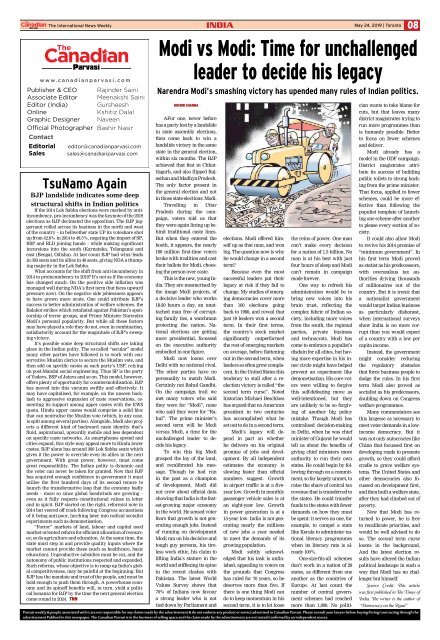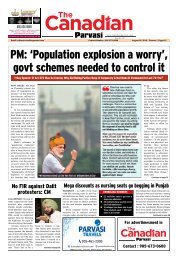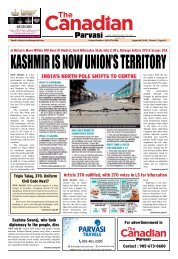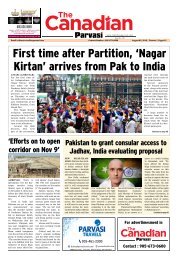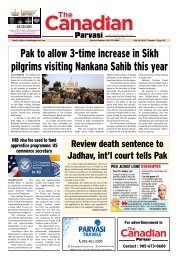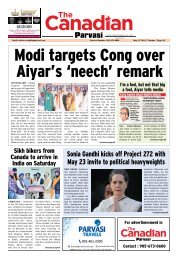You also want an ePaper? Increase the reach of your titles
YUMPU automatically turns print PDFs into web optimized ePapers that Google loves.
<strong>The</strong> International News Weekly India<br />
May 24, 2019 | Toronto 08<br />
<strong>The</strong><br />
w w w . canadianparv asi. c o m<br />
Publisher & CEO<br />
Associate Editor<br />
Editor (India)<br />
Online<br />
Graphic Designer<br />
Official Photographer<br />
Contact<br />
Editorial<br />
Sales<br />
Rajinder Saini<br />
Meenakshi Saini<br />
Gursheesh<br />
Kshitiz Dalal<br />
Naveen<br />
Bashir Nasir<br />
editor@canadianparvasi.com<br />
sales@canadianparvasi.com<br />
TsuNamo Again<br />
BJP landslide indicates some deep<br />
structural shifts in Indian politics<br />
If the 2014 Lok Sabha elections were marked by antiincumbency,<br />
pro-incumbency was the keynote of the 2019<br />
elections as BJP decimated the opposition. <strong>The</strong> BJP juggernaut<br />
rolled across its bastions in the north and west<br />
of the country – in bellwether state UP its voteshare shot<br />
up from 42.6% in 2014 to 49.5%, negating the impact of SP,<br />
BSP and RLD joining hands – while making significant<br />
incursions into the south (Karnataka, Telangana) and<br />
east (Bengal, Odisha). At last count BJP had wins/leads<br />
in 303 seats and its allies in 48 seats, giving NDA a thumping<br />
majority in the Lok Sabha.<br />
What accounts for the shift from anti-incumbency in<br />
2014 to proincumbency in 2019? It’s not as if the economy<br />
has changed much. On the positive side inflation was<br />
managed well during NDA’s first term (but faces upward<br />
pressure now). On the negative side joblessness appears<br />
to have grown more acute. One could attribute BJP’s<br />
success to better administration of welfare schemes, the<br />
Balakot strikes which retaliated against Pakistan’s sponsorship<br />
of terror groups, and Prime Minister Narendra<br />
Modi’s personal popularity. But while all these factors<br />
may have played a role they do not, even in combination,<br />
satisfactorily account for the magnitude of BJP’s sweeping<br />
victory.<br />
It’s possible some deep structural shifts are taking<br />
place in the Indian polity. <strong>The</strong> so-called “secular” model<br />
many other parties have followed is to work with conservative<br />
Muslim clerics to secure the Muslim vote, and<br />
then add on specific castes as each party’s USP, relying<br />
on post-Mandal social engineering. Thus SP is the party<br />
of Yadavs, BSP of Jatavs and so on. This model, however,<br />
offers plenty of opportunity for countermobilisation. BJP<br />
has moved into this vacuum swiftly and effectively. It<br />
may have capitalised, for example, on the unseen backlash<br />
to aggressive expansion of caste reservations, cementing<br />
its support among upper castes with the EWS<br />
quota. Hindu upper castes would comprise a solid bloc<br />
that can neutralise the Muslim vote (which, in any case,<br />
is split among several parties). Alongside, Modi also projects<br />
a different kind of backward caste identity that’s<br />
fluid, aspirational, upwardly mobile and less dependent<br />
on specific caste networks. As smartphones spread and<br />
cities expand, this style may appeal more to Hindu lower<br />
castes. BJP alone has around 300 Lok Sabha seats which<br />
gives it the power to override even its allies in the next<br />
government. With great power, however, must come<br />
great responsibility. <strong>The</strong> Indian polity is dynamic and<br />
the voter can never be taken for granted. Now that BJP<br />
has acquired enough confidence in government it must<br />
utilise the first hundred days of its second tenure to<br />
launch the transformative leap that the economy badly<br />
needs – more so since global headwinds are growing –<br />
even as it fully respects constitutional values in letter<br />
and in spirit. BJP started on the right, reformist note in<br />
2014 but veered off track following Congress accusations<br />
of it being anti-poor, lurching later into radical socialist<br />
experiments such as demonetisation.<br />
“Factor” markets of land, labour and capital need<br />
market-oriented reform for efficient allocation of resources;<br />
so do agriculture and education. At the same time, the<br />
state must step in and provide quality inputs where the<br />
market cannot provide these (such as healthcare, basic<br />
education). Unproductive subsidies must be cut, and the<br />
autonomy of public institutions respected and expanded.<br />
Such reforms, whose objective is to ramp up India’s global<br />
competitiveness, may be painful at the beginning. But<br />
BJP has the mandate and trust of the people, and must be<br />
bold enough to push them through. A powerhouse economy<br />
and its spinoff benefits will, in turn, yield a political<br />
bonanza for BJP by the time the next general election<br />
come round in 2024. TNN<br />
Modi vs Modi: Time for unchallenged<br />
leader to decide his legacy<br />
Narendra Modi’s smashing victory has upended many rules of Indian politics.<br />
RUCHIR SHARMA<br />
AFor one, never before<br />
has a party lost by a landslide<br />
in state assembly elections,<br />
then come back to win a<br />
landslide victory in the same<br />
state in the general election,<br />
within six months. <strong>The</strong> BJP<br />
achieved that feat in Chhattisgarh,<br />
and also flipped Rajasthan<br />
and Madhya Pradesh.<br />
<strong>The</strong> only factor present in<br />
the general election and not<br />
in those state elections: Modi.<br />
Travelling in Uttar<br />
Pradesh during the campaign,<br />
voters told us that<br />
they were again lining up behind<br />
traditional caste lines.<br />
But when they entered the<br />
booth, it appears, the nearly<br />
100 million first-time voters<br />
broke with tradition and cast<br />
their ballots for Modi, choosing<br />
the person over caste.<br />
This is the new, young India.<br />
<strong>The</strong>y are mesmerised by<br />
the image Modi projects, of<br />
a decisive leader who works<br />
18-20 hours a day, an unattached<br />
man free of corrupting<br />
family ties, a watchman<br />
protecting the nation. National<br />
elections are getting<br />
more presidential, focussed<br />
on the executive authority<br />
embodied in one figure.<br />
Modi now looms over<br />
Delhi with no national rival.<br />
<strong>The</strong> other parties have no<br />
personality to match Modi.<br />
Certainly not Rahul Gandhi.<br />
On the campaign trail we<br />
met many voters who said<br />
they were for “Modi”, none<br />
who said they were for “Rahul”.<br />
<strong>The</strong> prime minister’s<br />
second term will be Modi<br />
versus Modi, a time for the<br />
unchallenged leader to decide<br />
his legacy.<br />
To win this big Modi<br />
grasped the lay of the land,<br />
and recalibrated his message.<br />
Though he had run<br />
in the past as a champion<br />
of development, Modi did<br />
not crow about official data<br />
showing that India is the fastest-growing<br />
major economy<br />
in the world. He sensed voter<br />
fears that growth is not generating<br />
enough jobs. Instead<br />
of running on development<br />
Modi ran on his decisive and<br />
tough guy persona, his tireless<br />
work ethic, his claim to<br />
lifting India’s stature in the<br />
world and stiffening its spine<br />
in the recent clashes with<br />
Pakistan. <strong>The</strong> latest World<br />
Values Survey shows that<br />
70% of Indians now favour<br />
a strong leader who is not<br />
tied down by Parliament and<br />
elections. Modi offered himself<br />
up as that man, and won<br />
big. <strong>The</strong> question now is why<br />
he would change in a second<br />
term?<br />
Because even the most<br />
successful leaders put their<br />
legacy at risk if they fail to<br />
change. My studies of emerging<br />
democracies cover more<br />
than 100 elections going<br />
back to 1980, and reveal that<br />
just 19 leaders won a second<br />
term. In their first terms,<br />
the country’s stock market<br />
significantly outperformed<br />
the rest of emerging markets<br />
on average, before flattening<br />
out in the second term, when<br />
leaders so often grow complacent.<br />
In the United States this<br />
tendency to stall after a reelection<br />
victory is called “the<br />
second term curse”. Noted<br />
historian Michael Beschloss<br />
has argued that no American<br />
president in two centuries<br />
has accomplished what he<br />
set out to do in a second term.<br />
Modi’s legacy will depend<br />
in part on whether<br />
he delivers on his original<br />
promise of jobs and development.<br />
By all independent<br />
estimates the economy is<br />
slowing faster than official<br />
numbers suggest. Growth<br />
in airport traffic is at a fiveyear<br />
low. Growth in monthly<br />
passenger vehicle sales is at<br />
an eight-year low. Growth<br />
in power generation is at a<br />
15-year low. India is not generating<br />
nearly the millions<br />
of new jobs a year needed<br />
to meet the demands of its<br />
growing population.<br />
Modi subtly acknowledged<br />
that his task is unfinished,<br />
appealing to voters on<br />
the grounds that Congress<br />
has ruled for 70 years, so he<br />
deserves more than five. If<br />
there is one thing Modi can<br />
do to keep momentum in his<br />
second term, it is to let loose<br />
the reins of power. One man<br />
can’t make every decision<br />
for a nation of 1.3 billion. No<br />
man is at his best with just<br />
four hours of sleep and Modi<br />
can’t remain in campaign<br />
mode forever.<br />
One way to refresh his<br />
administration would be to<br />
bring new voices into his<br />
brain trust, reflecting the<br />
complex fabric of Indian society,<br />
including more voices<br />
from the south, the regional<br />
parties, private business<br />
and technocrats. Modi has<br />
come to embrace a populist’s<br />
disdain for all elites, but having<br />
more expertise in his inner<br />
circle might have helped<br />
prevent an experiment like<br />
demonetisation. His core voters<br />
were willing to forgive<br />
this self-defeating move as<br />
well-intentioned, but they<br />
are unlikely to be so forgiving<br />
of another big policy<br />
mistake. Though Modi has<br />
centralised decision-making<br />
in Delhi, when he was chief<br />
minister of Gujarat he would<br />
tell us about the benefits of<br />
giving chief ministers more<br />
authority to run their own<br />
states. He could begin by following<br />
through on a commitment,<br />
so far largely unmet, to<br />
raise the share of central tax<br />
revenue that is transferred to<br />
the states. He could transfer<br />
funds to the states with fewer<br />
demands on how they must<br />
be spent: it serves no one, for<br />
example, to compel a state<br />
like Kerala to administer national<br />
literacy programmes<br />
when its literacy rate is already<br />
100%.<br />
One-size-fits-all schemes<br />
don’t work in a nation of 29<br />
states, as different from one<br />
another as the countries of<br />
Europe. At last count the<br />
number of central government<br />
schemes had reached<br />
more than 1,000. No politician<br />
wants to take blame for<br />
cuts, but that leaves many<br />
district magistrates trying to<br />
run more programmes than<br />
is humanly possible. Better<br />
to focus on fewer schemes<br />
and deliver.<br />
Modi already has a<br />
model in the ODF campaign.<br />
District magistrates attribute<br />
its success of building<br />
public toilets to strong backing<br />
from the prime minister.<br />
That focus, applied to fewer<br />
schemes, could be more effective<br />
than following the<br />
populist template of launching<br />
one scheme after another<br />
to please every section of society.<br />
It could also allow Modi<br />
to revive his 2014 promise of<br />
“minimum government”. In<br />
his first term Modi proved<br />
as statist as his predecessors,<br />
with overzealous tax authorities<br />
driving thousands<br />
of millionaires out of the<br />
country. But it is ironic that<br />
a nationalist government<br />
would target Indian business<br />
as particularly dishonest,<br />
when international surveys<br />
show India is no more corrupt<br />
than you would expect<br />
of a country with a low per<br />
capita income.<br />
Instead, the government<br />
might consider reducing<br />
the regulatory obstacles<br />
that force business people to<br />
dodge the rules. In his first<br />
term Modi also proved as<br />
socialist as his predecessors,<br />
doubling down on Congress<br />
welfare programmes.<br />
Many commentators see<br />
this largesse as necessary to<br />
meet voter demands in a lowincome<br />
democracy. But it<br />
was not only autocracies like<br />
China that focussed first on<br />
developing roads to promote<br />
growth, so they could afford<br />
cradle to grave welfare systems.<br />
<strong>The</strong> United States and<br />
other democracies also focussed<br />
on development first,<br />
and then built a welfare state,<br />
after they had climbed out of<br />
poverty.<br />
Now that Modi has returned<br />
to power, he is free<br />
to recalibrate priorities, and<br />
would be well advised to do<br />
so. <strong>The</strong> second term curse<br />
looms in the background.<br />
And the latest election results<br />
have altered the Indian<br />
political landscape in such a<br />
way that Modi has no challenger<br />
but himself.<br />
Source Credit: This article<br />
was first published in <strong>The</strong> Times of<br />
India. <strong>The</strong> writer is the author of<br />
“Democracy on the Road”<br />
<strong>Parvasi</strong> weekly & people associated with it are not responsible for any claims made by the advertisement & do not endorse any product or service advertised in <strong>Canadian</strong> <strong>Parvasi</strong>. Please consult your lawyer before buying/hiring/contracting through the<br />
advertisement Publised in this newspaper. <strong>The</strong> <strong>Canadian</strong> <strong>Parvasi</strong> is in the business of selling space and the clains made by the advertisement are not tested/confirmed by an independent source.


